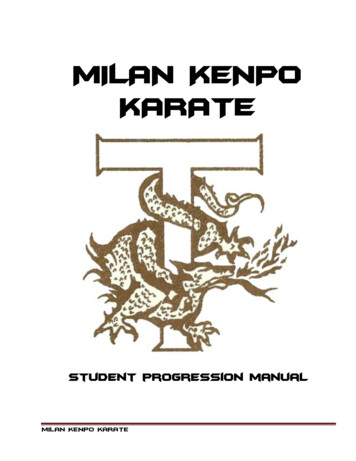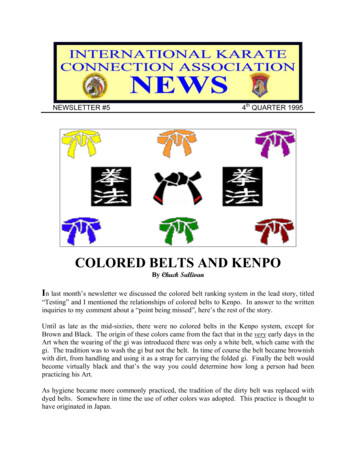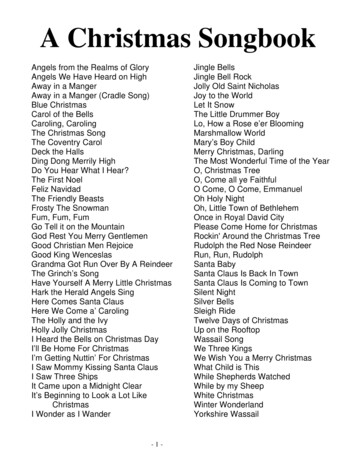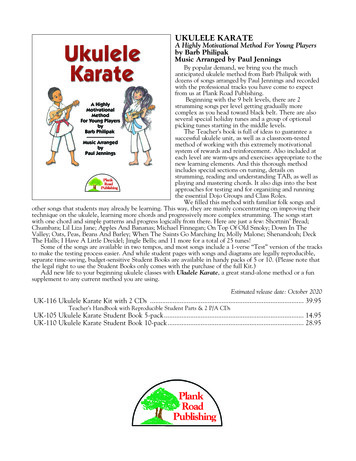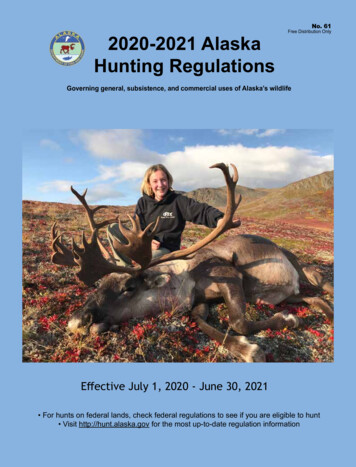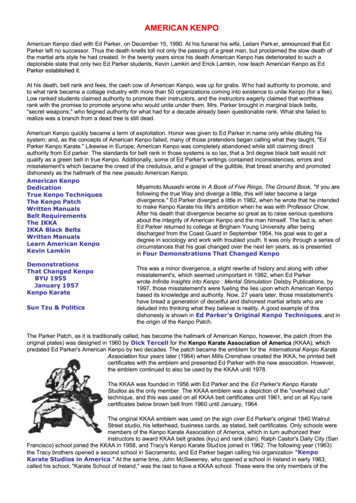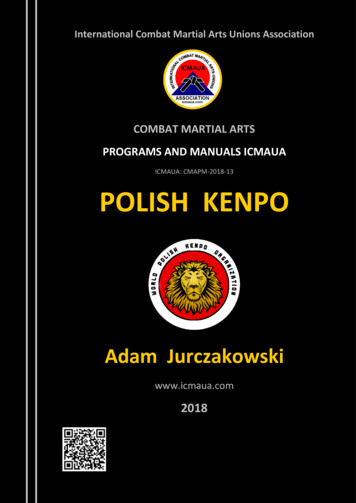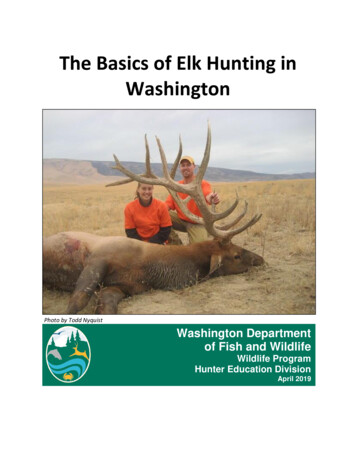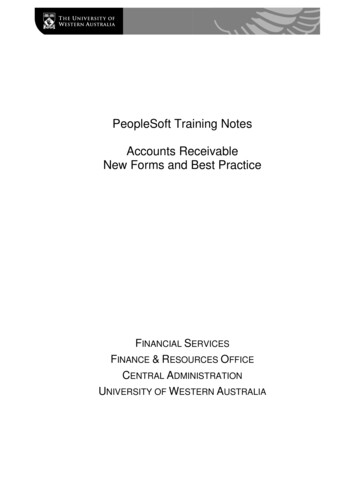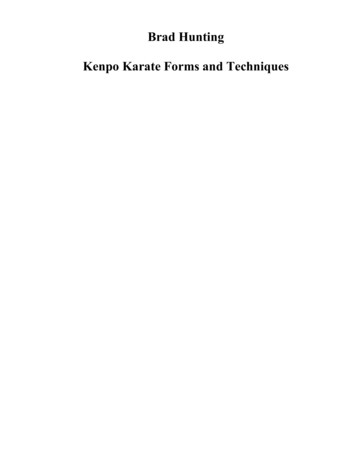
Transcription
Brad HuntingKenpo Karate Forms and Techniques
"I come to you with only Karate, empty hands, I have no weapons, butshould I be forced to defend myself, my principles or my honor;should it be a matter of life or death, of right or wrong; then here aremy weapons Karate, my empty hands."Ed Parker
The Kenpo Crest(from wikipedia.com)International Kenpo Karate Association crestThe design of the I.K.K.A Crest was completed in 1958 when the art of American Kenpo was gaininginternational notoriety. The crest design was meant to symbolically represent the art's modernized formwhile simultaneously acknowledging the roots of American Kenpo in traditional Chinese and Japanesemartial arts.TigerRepresents bravery, power, and physical strength. It is the early stage of a martial artist's learning. It isimportant to work on the basics (e.g to have a good horse stance) to prepare the body for lateradvancement. Also, the Tiger in Chinese culture represent the celestial guardian of the West cardinaldirection. The yin aspect of individual.DragonRepresents quintessence, fluidity, and agility, but also spiritual strength and the later stage of a martialartist's training. The dragon is placed above the tiger in the crest to symbolize the importance ofmental/spiritual strength over physical strength. This does not mean that physical strength isunimportant. What it does imply is that martial artists need to have a good moral to guide their physicalaction. Also, the Dragon in Chinese culture represent the celestial guardian of the East cardinaldirection. The yang aspect of individual.CircleThe circle represents continuity.Dividing LinesThe lines within the circle represent the original methods of attack first learned by ancient practitionersof the Chinese martial arts. They also demonstrate the pathways which an object could travel by.ColorsThe colors are representations of proficiency within the art alluding to the colored belt ranking system.The white represents the beginning stages and progresses through to black (expert level) and then red(professorship).Chinese CharactersThe writing acknowledges the art's Eastern roots. The characters on the right of the crest translate to"Law of the Fist, "Tang/Chinese Hand (唐手)" or "Empty Hand"(空手)" a.k.a. "Kenpo Karate". Thecharacters on the left translate to "Spirit of the Dragon and the Tiger."ShapeThe shape of the crest represents the structure of a house. The walls and roof are curved to keep evilfrom intruding. The ax at the bottom of the crest is a solemn reminder that should a martial artist tarnishthe reputation of the organization they will be "cut off" completely.
1. THE TIGER — represents earthly strength derived during the early stages of learning. This is the stage wherethe individual is more impressed with his own physical prowess.2. THE DRAGON — represents spiritual strength which comes with seasoning. This mental attitude is attainedduring the individual’s later years of training. It is placed above earthly strength (as indicated and observed onthe patch) since the individual at this stage has learned to develop humility and self restraint.The attitude of the Dragon is the ultimate goal of KENPO. Armed with this attitude an individual will not be afraidof the opponent but of what he can do to the opponent. Thus he turns his back and walks away from anunwarranted conflict confident that he could have been the victor.3. THE CIRCLE — is symbolic of several things: (1) It depicts life itself, a continuous cycle where there is nobeginning nor end. So is it with the art of KENPO, it too is a cycle of perpetual and unending movement ormotion. Techniques follow a cycle, movements are a part of a cycle, physical prowess, humility and self restraintare no more than components of a progressive learning cycle; (2) All moves evolve from a circle whether theyare offensive or defensive; (3) The circle represents the bond of friendship that should continuously exist amongIKKA members; and (4) The circle is the base from which our alphabet stems.4. THE DIVIDING LINES — in the circle represents: (1) the original eighteen hand movements—directions inwhich the hands can travel; (2) They are the angles from which an opponent or you can attack or defend; and (3)it forms the pattern in which the feet too can travel—explanation of the Universal Pattern will clarify this.5. THE COLORS — represents proficiency, achievement and authority. The circle is GRAY because it issymbolic of the brain—the brain of the IKKA, since the brain has always been referred to as GRAY matter. TheWHITE background is significant of the many beginners who form the base of the Art. The YELLOW andORANGE represents the first level of proficiency—the mechanical stage—the dangerous stage in learning wherethe student is more impressed with the physical who, like the freshman in college, thinks he knows all of theanswers. BROWN, the color of the Tiger's eyes, represents the advanced students though not in great number.Also at this level the student becomes more observant. His eyes, like that of the Tiger, are keen, ever sowatchful and critical, always looking up to the higher levels of proficiency, striving for perfection, preparing for theday he bares the level of an expert. This level of expert proficiency is represented by the color BLACK. RED isthat of professorship over and above BLACK but yet, as indicated by the colors of the Dragon, there are stilltraces of WHITE in the Dragon's eyeball, YELLOW or ORANGE on the Dragon's fins, BROWN in the iris of theeyeball, and BLACK in the pupils of the eyeball. This is to remind even the Professor that he too should alwaysbe so humble and be able to go back to any level, whatever it might be, and perform the things that he expectsof others at these levels so as never to demand too much of his students.6. THE ORIENTAL WRITING — is a reminder of the originators of our Art—the Chinese. It is in respect to thembut not that we serve them. The lettering to the right means KENPO KARATE—Law of the Fist and the EmptyHand—the art that we practice. To the left it means Spirit of the Dragon and the Tiger—a constant reminder thatwe want to attain the spiritual level and that the physical level is only a stepping stone or vehicle, that we use toreach the higher or spiritual level.7. THE SHAPE — The TOP of the crest is like a roof which gives shelter to all who are under it. The SIDES )( are curved conversely because, like the roof of a Chinese home, it is to send evil back to where it came from,whenever it tries to descend. The BOTTOM forms the shape of an axe—it represents the executioner—in theevent a member is influenced by evil ideas and thoughts contrary to our philosophy, or shames the IKKAorganization, he is cut off, never to coexist with us again.— Ed Parker, Infinite Insights into Kenpo, Volume 1, Chapter 2. 1982.
The Greeting and the StoryMake a fist (right hand at your right shoulder).The WarriorCover the fist (left hand).and the ScholarStep forward right (twist stance), step forward left (Cat stance).go off to battleHands back to back extended in front of you (thumbs pointing down).and fight back to backRoll thumbs up toward you as you step back left then right and go to position.retreat in victoryDouble elbow strike at attention stance.pulling the countries togetherWipe off knees as you go to a horse stanceHigh (hands extended out away from the body above your head(index finger touching, thumbs are not touching).Mind, Body and SpiritMiddle (clenched right fist, left hand covers fist in front of your heart).Concealing my treasureLow (palms together close to the body). .Praying for wisdomShot hands up the center line, make the shape of a heart.Shape of a heart for the love of the ArtPause for the claws (arms at shoulder height with double palm claws)Simultaneously, bring hands to hips with the left foot sliding back to attention and bow
Forms with Accompanying ThemesShort Form 1 (Four Shields) – blocking only Blocking while gaining distanceLong Form 1 (Shield and Mace) – blocking and striking Blocking and Countering while gaining distanceShort Form 2 (The Cat) – utilizes cat stance movements Aggressively defending in a confined space with fluidityLong Form 2 (Continuous Set) – emphasizes many continuous and fluid movements Aggressively defending with blocking and countering with multiple strikes filling the gaps with fluidityTechnique Based FormsThese forms are made of individual self defense techniques, with foot transitions between the movements.Short Form 3 (Single Escape Set) – this form is comprised of self defense techniques against individual grabs.Most techniques are only partially completed.Long Form 3 (Double Escape Set) – this form is also comprised of self defense techniques against individualgrabs, but does the movement on for both sides. Most techniques are done completely.Long Form 4 (Definitive Set) – With techniques, done on both sides, against various strikes. Encyclopedia of the SystemForm 5 (Transition Set/Take Down Set) – Techniques against strikes and grabs, done both sidesForm 6 (Weapon Set) – Techniques against attacks with weapons, done both sides.Form 7 (Stick Set) – This form has many techniques with large circular movements vs linear moves.
Punch SetNote: Each strike alternates starting with the right hand then the left hand1. Right Middle Punch / Left Middle Punch (Nose)2. Right High Punch / Left High Punch (Stomach)3. Right Low Punch / Left Low Punch (Groin)4. Right Twisty Punch / Left Twisty Punch (10:30/1:30)5. Right Inward Chop / Left Inward Chop (Neck)6. Right Outward Chop / Left Outward Chop (Neck)7. Right Uppercut / Left Upper Cut (Stomach)8. Right Upward Elbow / Left Upward Elbow (Chin)9. Right Downward Elbow / Left Downward Elbow (Between the Shoulder Blades)10. Right Inward Elbow / Left Inward Elbow (Face)11. Right Outward Elbow / Left Outward Elbow (Chin)12. Double Chop13. Hassa!Phase 1 - erPantherCraneCraneBack Fist / Reverse PunchBack Fist / Reverse punch / Front snap kick (lead leg)Back Fist / Reverse Punch / Step Through Round KickLunging Back Fist / Reverse PunchLunging Back Fist / Reverse Punch / Step Through Round Kick / Shuffle Up Lead Leg Side KickStep-thru front snap kick / Step-thru front snap kick / Reverse punchBack Fist / Side Kick / Step Through Front KickLead Arm Vertical Punch /Shuffle Up Round House Kick / Reverse PunchVertical Punch / Shuffle Front Snap KickShuffle-up vertical thrust punch / Front snap kickBase Ten Set1. Delayed Sword2. Alternating Mace3. Sword of Destruction4. Deflecting Hammer5. Captured Twigs6. The Grasp of Death7. Checking the Storm8. Mace of Aggression9. Attacking Mace10. Sword and Hammer
FUNDAMENTALSSword in ReturnParting the SeaKick in ReturnCircling TwigPassing the HorizonDelayed SwordAlternating MaceSword of DestructionDeflecting HammerCaptured TwigsThe Grasp of DeathMace of AggressionRolling MaceAttacking MaceSword and HammerChecking the StormRight-handed lapel grab (or punch) from 12:00Two-handed mid-section push from 12:00Right punch to head from 12:00Right-hand cross-wrist grab from 12:00Right hammerlock from rear (6:00) while holding left wristRight-handed lapel grab (or punch) from 12:00Two-handed chest-high push from 12:00Left round house punch to head from 12:00Right / Left thrusting front kick to mid-section from 12:00Bear hug from behind, arms pinnedFrom left flank; right handed head lockTwo handed lapel grabTwo handed push to midsectionRight punch to headLeft hand grab to right shoulder from behind at 4:30Right side overhead club attack from 12:00Tiger Cycle – Level 1Clutching FeathersTriggered SaluteDance of DeathThrusting SaluteThe GiftLocking HornsHair grab from 12:00Right straight thrust to shoulderRight punch to headRight through KickRight hand shakeHead lock from front, right arm belowCrane Cycle – Level 1Lone KimonoGlancing SaluteFive SwordsBuckling BranchScraping HoofThe GripLeft arm straight lapel grabRight cross push to shoulderRight round house to headRight through kickFull nelson from behindRight head lock while moving forwardLeopard Cycle – Level 1Crossing TalonRepeating MaceShielding HammerThrusting SaluteStriking Serpents HeadLocked WingRight cross wrist grabLeft handed cross push to left shoulderLeft round house punch to headLeft through kick to mid sectionBear hug from front with arms freeHammer lock from left rearMantis Cycle – Level 1Obscure WingSnapping TwigReversing MaceBuckling BranchThrusting PalmsTwisted TwigLeft handed grab to right shoulder, close in from right flankLeft handed chest push or grab from 12:00Left punch to head from 12:00 (Parry, Pizza, Pow)Left thrusting kick to mid-section from 12:00Bear hug from 12:00 with arms pinnedRight wrist lock from 12:00 (palm inward)
Lion Cycle – Level 2 – Strike Set OneBegging HandsStraight wrist grab to both wrists from 12:00Encounter with DangerTwo handed mid-section push from 12:00 knocking you to the groundFlashing WingsStep through right straight punch to head from 12:00Rotating DestructionRight step through front kick followed by a left spinning back heel kick from 12:00Repeated DevastationSuccessful full nelson from 6:00Entangled WingFigure 4 wristlock to right wrist from 12:00Brushing the StormRight step through overhead club strike from your right flank 3:00Monkey Cycle – Level 2 – Coordination Set OneRaking MaceTwo-handed lapel grab pulling in from 12:00Leap from DangerPush from 6:00Shield and MaceStep-through right straight punch to head from 12:00Hugging P
Kenpo Karate Forms and Techniques "I come to you with only Karate, empty hands, I have no weapons, but should I be forced to defend myself, my principles or my honor; should it be a matter of life or death, of right or wrong; then here are my weapons Karate, my empty hands." Ed Parker. The Kenpo Crest (from wikipedia.com) International Kenpo Karate Association crest The design of the I.K.K.A .File Size: 364KBPage Count: 71
